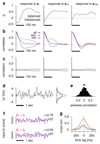Optimal control of transient dynamics in balanced networks supports generation of complex movements
- PMID: 24945778
- PMCID: PMC6364799
- DOI: 10.1016/j.neuron.2014.04.045
Optimal control of transient dynamics in balanced networks supports generation of complex movements
Abstract
Populations of neurons in motor cortex engage in complex transient dynamics of large amplitude during the execution of limb movements. Traditional network models with stochastically assigned synapses cannot reproduce this behavior. Here we introduce a class of cortical architectures with strong and random excitatory recurrence that is stabilized by intricate, fine-tuned inhibition, optimized from a control theory perspective. Such networks transiently amplify specific activity states and can be used to reliably execute multidimensional movement patterns. Similar to the experimental observations, these transients must be preceded by a steady-state initialization phase from which the network relaxes back into the background state by way of complex internal dynamics. In our networks, excitation and inhibition are as tightly balanced as recently reported in experiments across several brain areas, suggesting inhibitory control of complex excitatory recurrence as a generic organizational principle in cortex.
Copyright © 2014 Elsevier Inc. All rights reserved.
Figures








Comment in
-
Bringing the dynamics of movement under control.Neuron. 2014 Jun 18;82(6):1193-5. doi: 10.1016/j.neuron.2014.06.002. Neuron. 2014. PMID: 24945762
References
-
- Amit DJ, Brunel N. Model of global spontaneous activity and local structured activity during delay periods in the cerebral cortex. Cerebral Cortex. 1997;7:237–252. - PubMed
Publication types
MeSH terms
Grants and funding
LinkOut - more resources
Full Text Sources
Other Literature Sources

